
JAMES R. ARNOLD
TET OFFENSIVE 1968. TURNING POINT IN VIETNAM
US FORCES AND STRENGTHS, 31 JANUARY 1968
Divisions
1st Marine Division (22,466)
3rd Marine Division (24,417)
1st Cavalry Division (18,647) (the Army's best)
1st Infantry Division (17,539)
4th Infantry Division (19,042)
9th Infantry Division (16,153)
23rd (American) Division (15,825) (newly formed)
25th Infantry Division (17,666)
101st Airborne Division (15,220) (airborne in name only)
Brigades and Other Units
173rd Airborne Brigade (5,313)
199th Infantry Brigade (4,215)
11th Armored Cavalry Regiment (4,331)
5th Special Forces Group (Airborne) (3,400)
Summary
79 Army battalions, 23 Marine battalions, 3,100 helicopters
Allied Forces
1st Australian Task Force (three battalions, about 6,000)
Royal Thai Army Volunteer Regiment (Queen's Cobras) (about 2,400)
Capital (Tiger) Infantry Division (Korean)
9th (White Horse) Division (Korean)
2nd Marine Corps Brigade (Korean)
Authorized Korean manpower: 42,769
Actual pre-Tet strength: 48,800
ARMY REPUBLIC OF SOUTH VIETNAM
Airborne Division (élite)
Marine Corps (two solid 3-battalion brigades)
1st Division (the best regular division)
2nd Division (problem-prone, high desertion)
5th Division (barely effective)
7th Division (barely effective)
9th Division (the Army's poorest)
18th Division (combat-ineffective)
21st Division (a good division)
22nd Division (adequate, improving)
23rd Division (adequate, improving)
25th Division (improved after receiving M-16s)
Ranger Battalions (uneven, from very good to poor)
Regional Forces (151,376 militia)
Popular Forces (148,789 militia)
Civilian Irregular Defence Groups (42,000 militia)
Total Allied Forces as of 31 December 1967: 1,298,000
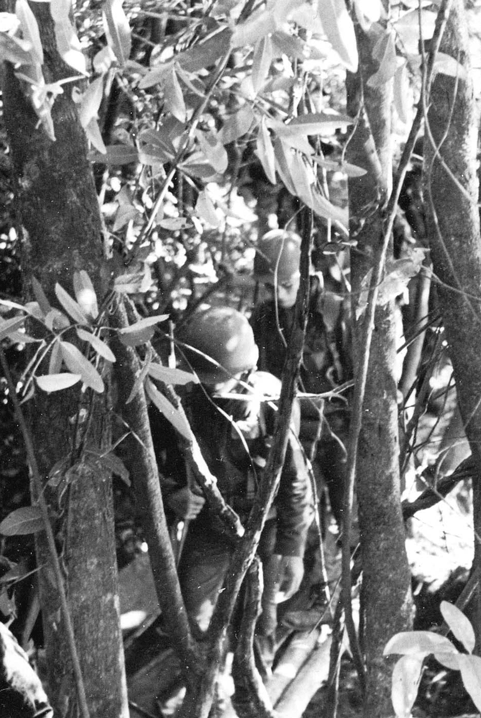
Paratroopers of the élite ARVN Airborne served as a fire brigade force. The 1st and 8th Battalions, intended for movement north as part of Westmoreland's counter to the NVA buildup along the DMZ, were still in Saigon when the Communists struck. Their fortuitous presence gave the Allied commanders an invaluable hard-lighting reaction force. During Tet, airborne troopers rushed from one emergency to the next.
At the bottom of the pecking order of Allied units were the 42,000 men comprising the Civilian Irregular Defence Groups (CIDG). The task of Training and leading these groups fell to the American and Vietnamese Special Forces. There were two categories of CIDG: Camp Strike Forces (CSF) and Mobile Strike Forces (MSF, familiarly known as 'Mike Forces'). The former garrisoned the Special Forces' camps while the latter comprised the better trained soldiers (a relative term) capable of active patrolling. A battalion of CSF soldiers, three to five 132-man companies, guarded each camp. Their families usually lived in an adjacent American-built slum put together with nipa palm and stolen materials. In remote situations these camps existed in isolation from normal regional life; in more populous areas they became a centre for people seeking a safe haven. Since one of the goals of the coming offensive was to prove to the people that the South Vietnamese government and its allies could not protect its citizens, the CIDG camps were included on the target list.
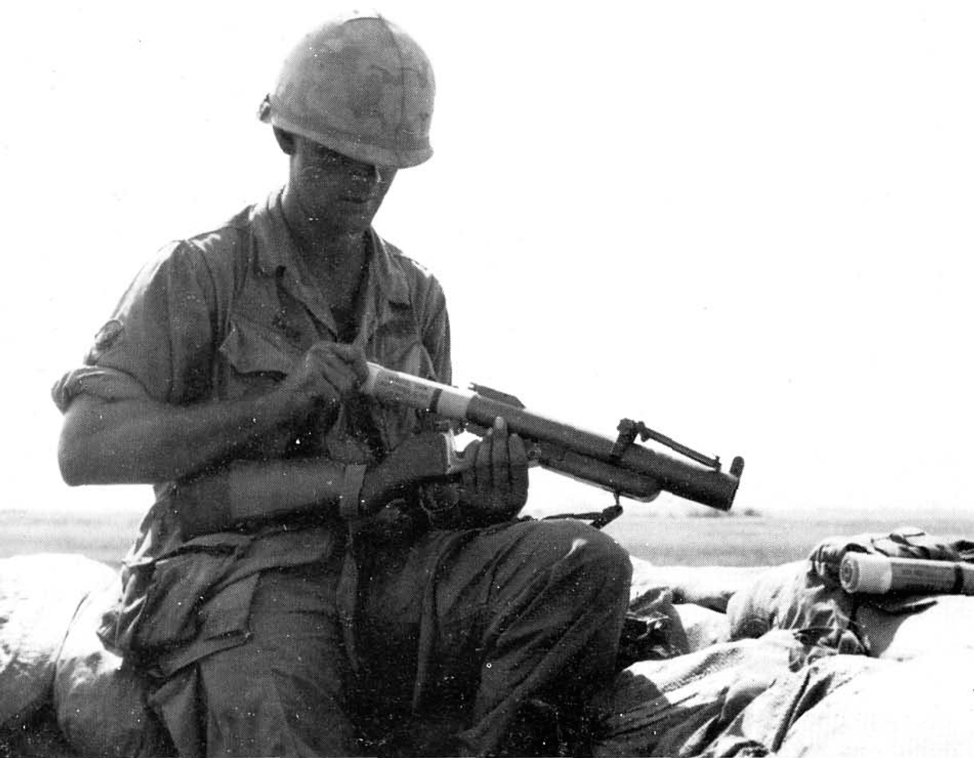
South Vietnam Military Regions
A soldier of the 5th Marine Battalion holds a VC 75mm recoilless rifle round.
1st ARVN Division radiomen and their American advisers coordinate operations with a nearby American Fire Support Base.

The CIDG had limited capabilities. They were at the bottom of the hierarchy for supplies, medical evacuation, fire support, and everything else. Most of their training came from field experience facing 'real' training aids who shot back with superior weapons. However, moulded by the Green Berets, they sometimes accomplished surprising feats. A Special Forces officer has left a description of his men on the eve of Tet:
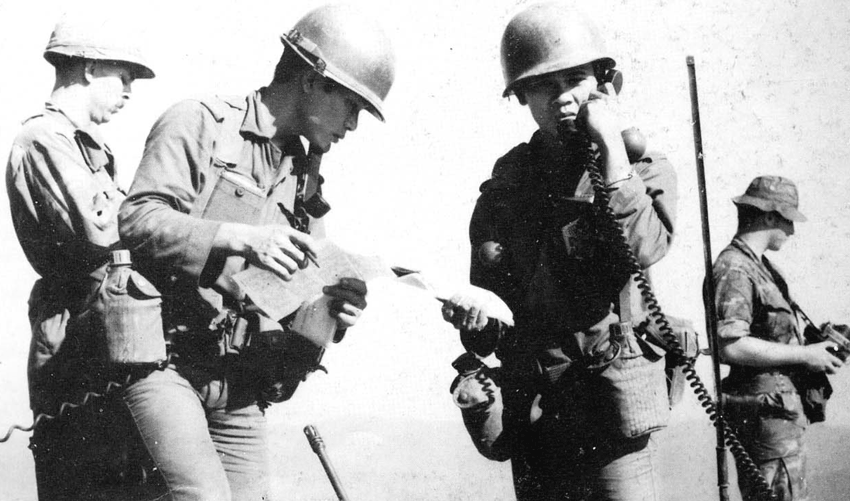
'These CIDGs were soldiers who would cut up their canteen covers to make green fur collars for their uniforms; who could struggle all day through thigh-deep mud, carrying half their own weight on their backs without complaint... who would bang two B-40 rockets together like indian clubs to see if they would explode... who might run under fire; or who might ignore it to carry a wounded American to safety.'
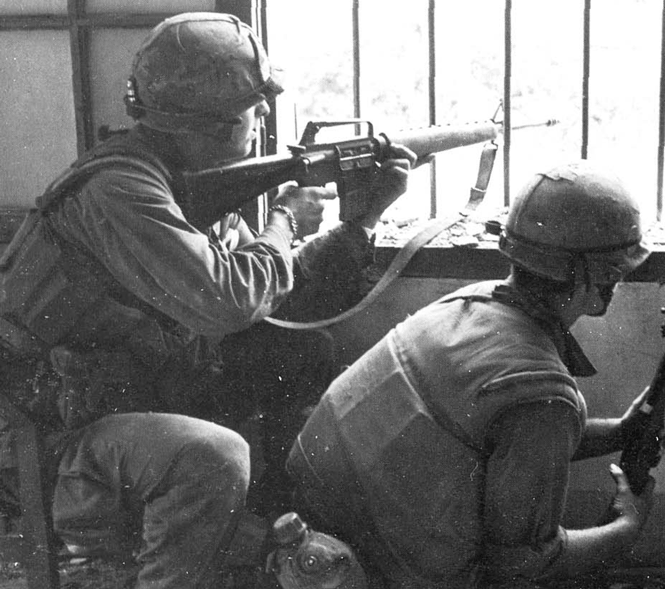
The M-16 was the basic and controversial firearm of the US foot soldier. In automatic rifle, on full automatic it delivered its 20-round magazine in three seconds. To reduce the likelihood of jamming, many soldiers only loaded 18 rounds. Still the M-16 had to be meticulously maintained or else it jammed. The relative merits of the rival automatic rifles were much debated. One VC company commander stated: 'The AK-47 was a good weapon, but most of us carried M-16s.' Asked why, he responded: 'It was so much easier to get ammunition. You were always dropping magazines full of it, or we could buy it from the puppet (South Vietnamese) forces.' A Marine belonging to 'A' Company, 1/1 Marine Regiment, during the Battle of Hue, 9 February 1968.

Even squad included a soldier armed with the M-79 grenade launcher. The M-79 was a single-shot, break-open, breech-loaded shoulder weapon. When loaded it weighed 6.5 pounds. It fired a 40mm grenade to an effective range of 400 yards (while the maximum range of a hand-lobbed grenade was 40 yards). It had a sustained rate of aimed fire of five to seven rounds per minute. Grenadiers carried ammunition in specially designed, pouch-lined jackets. The effectiveness of the 'blooper' gunners made them, along with the radiomen, the first targets in an ambush. A VC captain commented: 'We were very frightened of it... A terrible weapon.'
Except for selected CIDG camps, the Communist assault tended to bypass rural areas in favour of city assaults. Thus, the 151,376-man Regional Forces and 148,789-man Popular Forces played a limited part in the Tet Offensive. In the cities the attackers confronted the 70,000-man Vietnamese national police who were forced to play a combat role with which they were unfamiliar and for which they were ill-prepared.
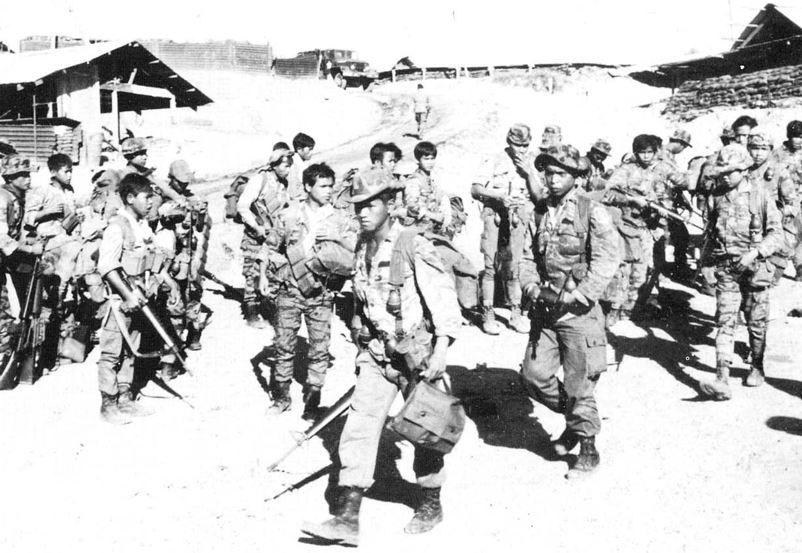
A CIDG platoon at its base in the II Corps hinterland. Note the many young teenagers that make up this force.
On the eve of Tet, US forces comprised nine divisions, one armoured cavalry regiment, and two independent brigades. This force had 100 infantry and mechanized battalions numbering 331,098 Army soldiers and 78,013 Marines. The most aggressive of these troops, the Marines, 1st Cavalry Division, 173rd Airborne Brigade, and 11th Armored Cavalry Regiment, were the equal of any of the crack American formations that participated in the two World Wars. The balance were dependable, if unexceptional, soldiers willing to perform their duty.
Writing with the advantage of hindsight, an American officer commented that his country did not acquire ten years' experience in Vietnam, but rather had 'one year's experience ten times'. The reason for this was the rotation system under which a soldier served a twelve-month tour of duty. Every soldier knew to the day his personal DEROS (Date Expected Return Overseas). Most soldiers' prime motivation was to survive until that day. The Vietnam rotation policy differed from previous wars. During the two World Wars soldiers served for the duration. In Korea, rear-echelon troops served longer than those in combat units. In Vietnam, every one served the same tour. Typically, for several weeks following arrival in country, a soldier was excited and perhaps looked forward to combat, lie lost this enthusiasm after his first engagement. From about the second to the eighth month he performed his combat role dutifully. Then he began to consider himself an 'old soldier' and, like all such, became reluctant to take risks. Often, as a soldier neared his DEROS, sympathetic officers gave him a more secure assignment.
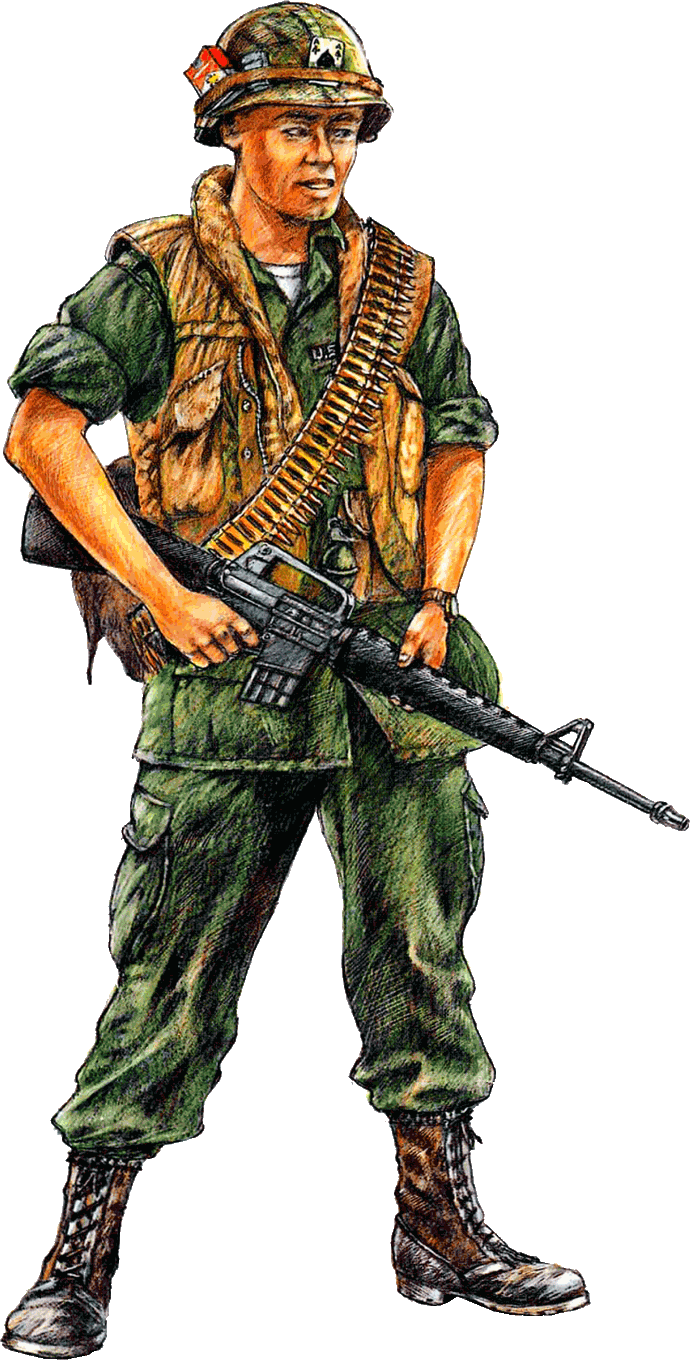
US infantryman. Illustration by Richard Geiger
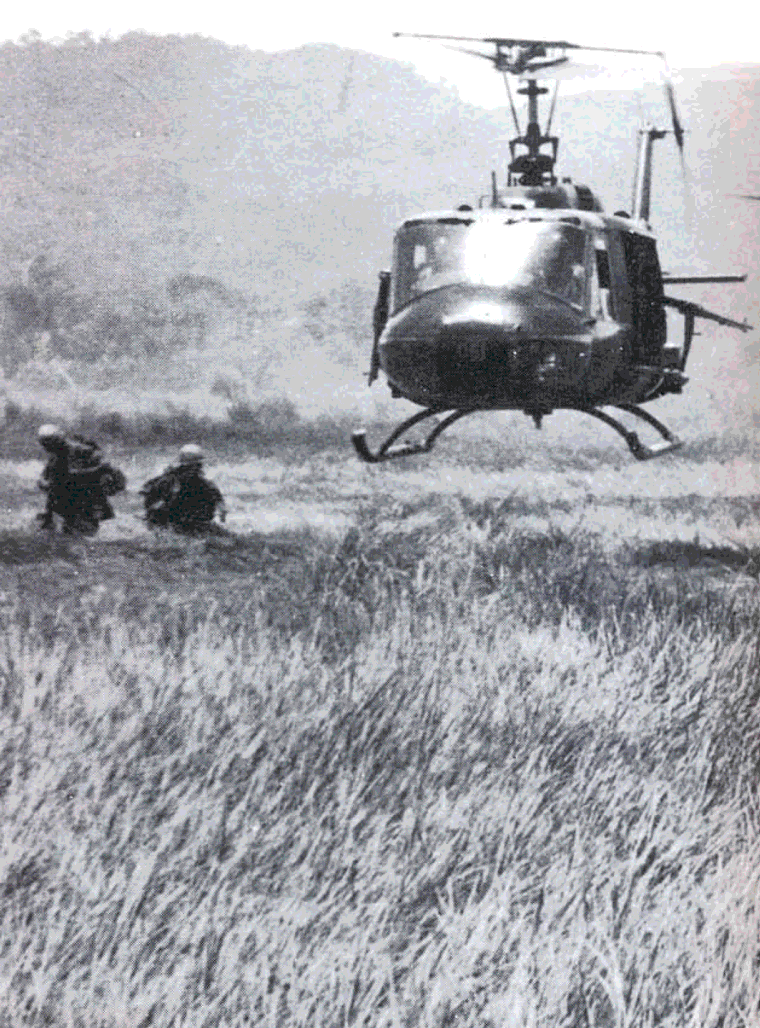
The rotation policy had a major impact on how America fought the war. Rapid manpower turnover hindered the development of esprit de corps. There was a constant influx of green troops replacing combat experienced men. Since the likelihood of encountering the enemy was somewhat random, a newly arrived soldier had about the same chance of engaging in hard combat as did an experienced soldier. A North Vietnamese officer commenting on why America lost said: 'One weak point was your rotation of soldiers. You were strangers here anyway, and as soon as someone began to learn the country you sent him home.' Thus, from the soldiers' standpoint, the major morale factor was the rotation policy. He knew the war would not be won during his tour of duty, so he reasonably asked 'why try?'. His patriotic and self-sacrificial tendencies competed with instincts for self-preservation. For him: 'The end of the war was marked by the individual's rotation date and not by the war's eventual outcome - whether victory or defeat.'
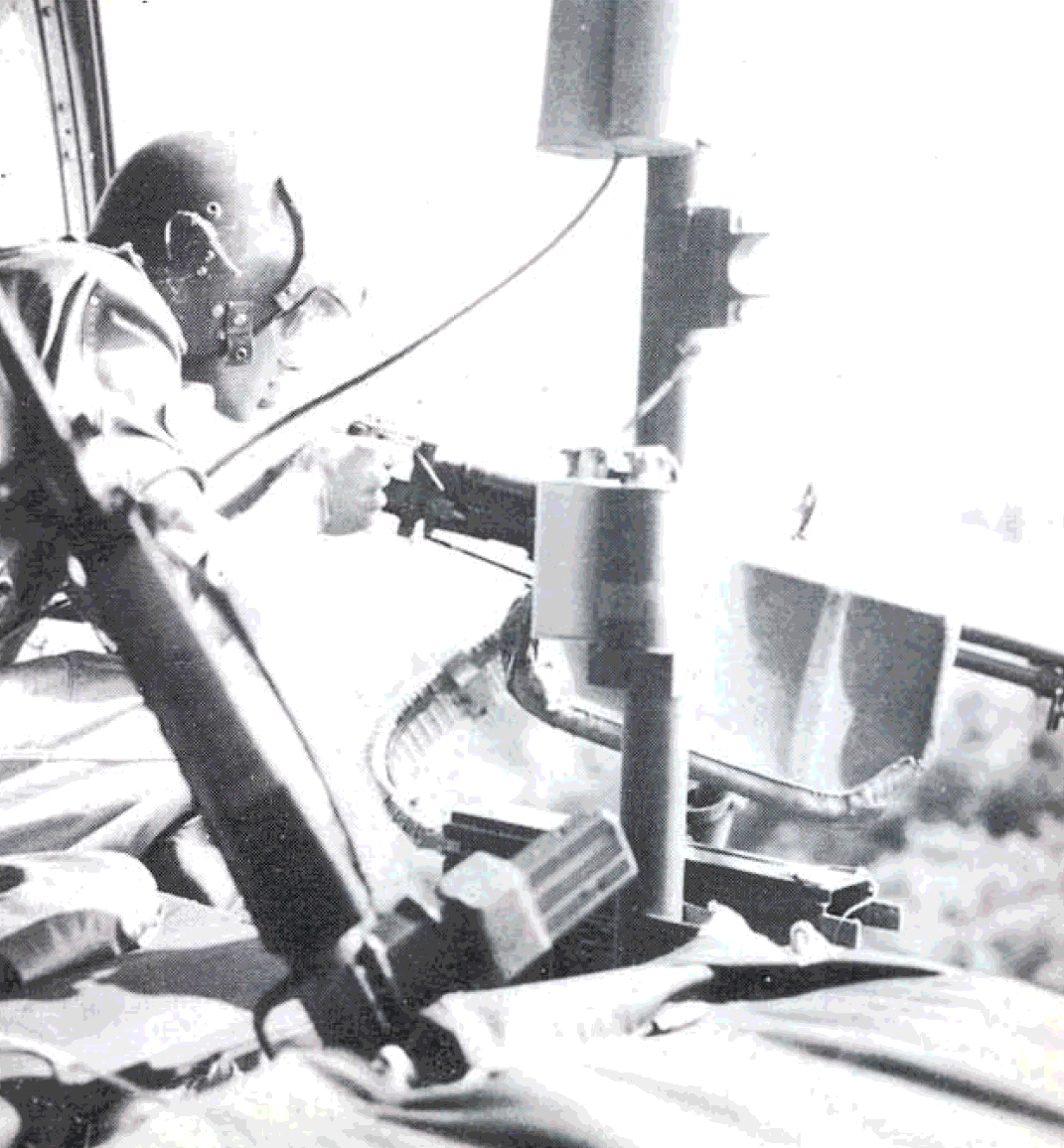
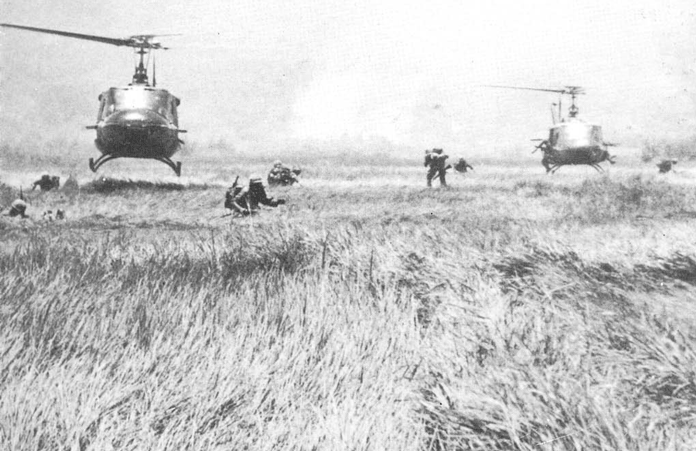
Vertical envelopment, landing troops via helicopter behind enemy lines, was a new military concept, first applied during the Vietnam War. In 1965 and 1966, when the Communists first confronted this new weapon, they were taken by surprise and slaughtered in droves. But the helicopter was a mixed blessing. A North Vietnamese general who commanded in the first battles against the US 1st Cavalry Division commented: 'With your helicopters you could strike deep into our rear without warning. It was very effective.' However, 'We were amazed at how dependent you were on helicopters.' The helicopter gave the illusion of control. Troops could land anywhere the terrain permitted, deep within enemy-dominated territory. But once they departed the land reverted to the enemy.

In important part of the American arsenal was the helicopter gunship. A crew chief fires his M-60 at a Viet Cong position.
The gunner's view: in this case friendly soldiers of the 1st ARVN Division sweeping through a hamlet. When targets could be seen, the helicopter gave the Allies what in wars past had been called the 'high ground'.

As in most wars, there was not a 'typical' soldier on either side. Because of the difficult jungle terrain, field expedients ruled the day. An American foot soldier going on patrol might earn a rucksack stuffed with basic equipment weighing some 50 pounds. In addition, he hefted three days' rations, 500 M-16 rifle rounds, four one-pound fragmentation grenades, two smoke grenades, one or two Claymore mines, 200 rounds for his unit's M-60 machine-gun, three or four canteens of water and his individual weapon. Here, 1st Infantry Division soldiers take a break from a tracking patrol.
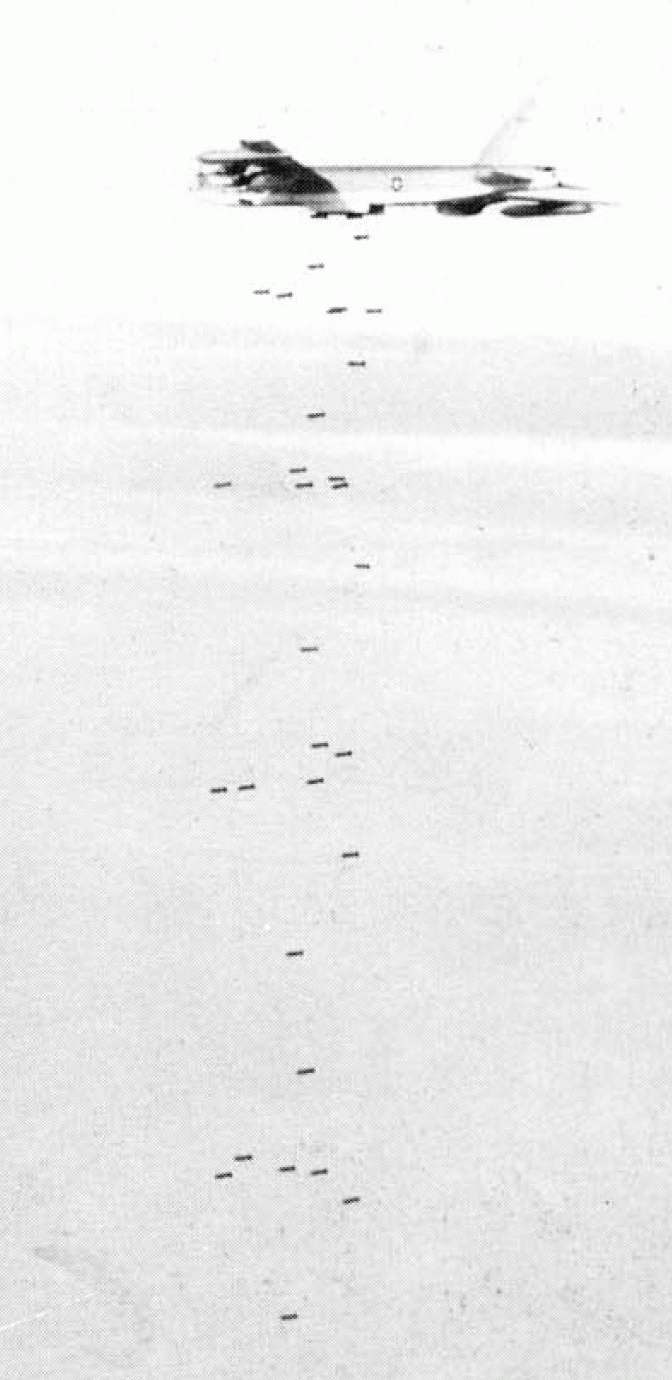
Flying from bases in Guam, the B-52 bomber - originally designed for strategic nuclear attack - served as a conventional ground support bomber in South Vietnam. It carried a colossal bomb load, up to 84.750-pound bombs, that could be dropped as close as one kilometre from friendly troops. The B-52 flew so high that it could not be heard on the ground: thus in theory they struck without warning. However, Soviet vessels stationed near the B-52 bases, spies' reports from the heavily infiltrated South Vietnamese command, and careless American security measures frequently gave the intended target advance warning. None the less, B-52 carpet bombing attacks could he devastating and greatly contributed to the defence of Khe Sanh.
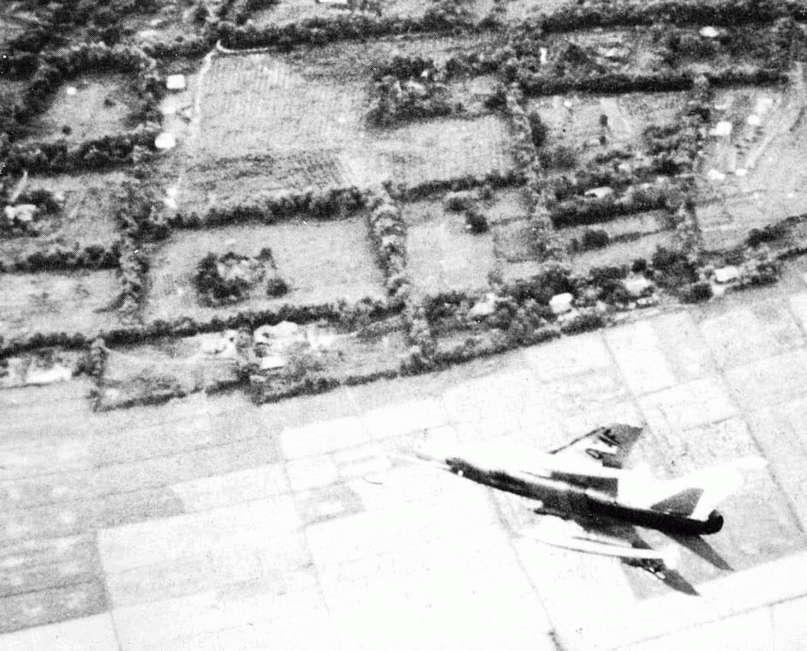
Jet strike aircraft provided close support in daylight conditions of good visibility. Because of their speed, the 'fast-movers' were hard targets for enemy anti-aircraft gunners to hit. Although the Americans used a variety of jet aircraft, the Air Force's F-100 Super Sabre was the most common jet used in South Vietnam. It carried up to 6,000 pounds of ordnance.
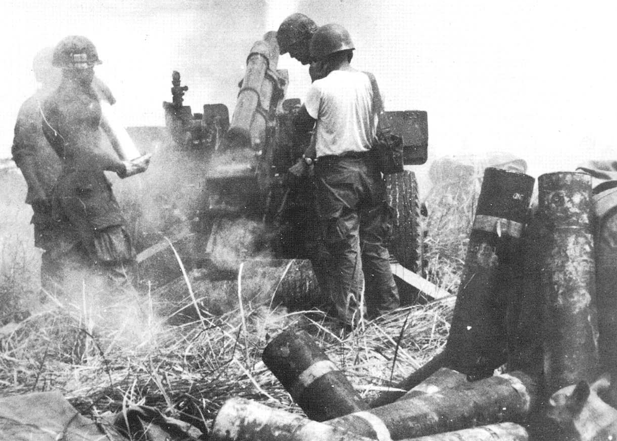
The NVA/VC had to confront a battlefield fact of life: they invariably faced vastly superior American firepower. They constantly sought ways to compensate by using every possible strategy conceivable by a very inventive people. These ranged from pre-battle morale/political indoctrination to post-battle evasion and retreat tactics.
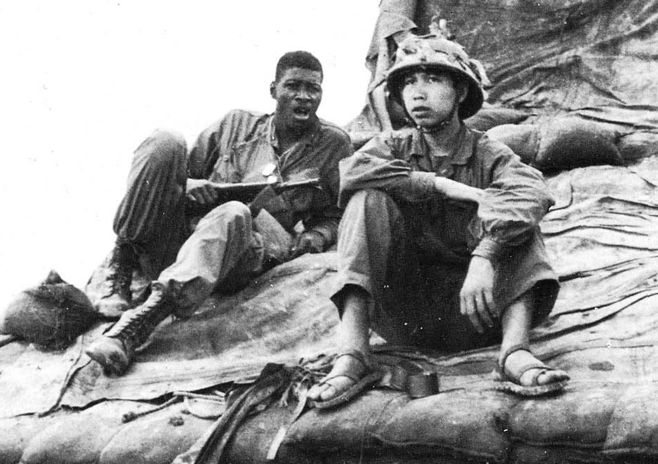
A captured NVA regular wears the characteristic Ho Chi Minh sandals and pith helmet. Heavy Tet losses among southern-born Viet Cong shifted the, war's burden to the northern regulars.
The rotation policy also had an adverse impact on the officer corps. Knowing their time was limited, many officers selfishly sought to enhance their careers during their Vietnam service. This was the infamous 'ticket punching' behaviour so criticized after the war. The officer's goal was not to win the war, but to acquire a good fitness report for his file. Furthermore, career officers strove to serve six months in a combat unit and six in a staff position. This combined experience gave them the best chance for future promotion. Yet it had a serious adverse impact on operations in the field. Just about the time an officer became experienced enough to lead effectively, he switched jobs. A new commander brought new procedures, and even- one constantly had to change, adjust and relearn all aspects of combat. This was a serious disadvantage, particularly against a foe who had fought a lifetime on the same ground.
The fundamental military challenge confronting the Americans and their allies was that, despite unprecedented mobility provided by helicopters and APCs, they infrequently contacted the enemy unless he wanted the contact. The Tet Offensive changed this. The enemy massed his forces and tried to hold his ground.
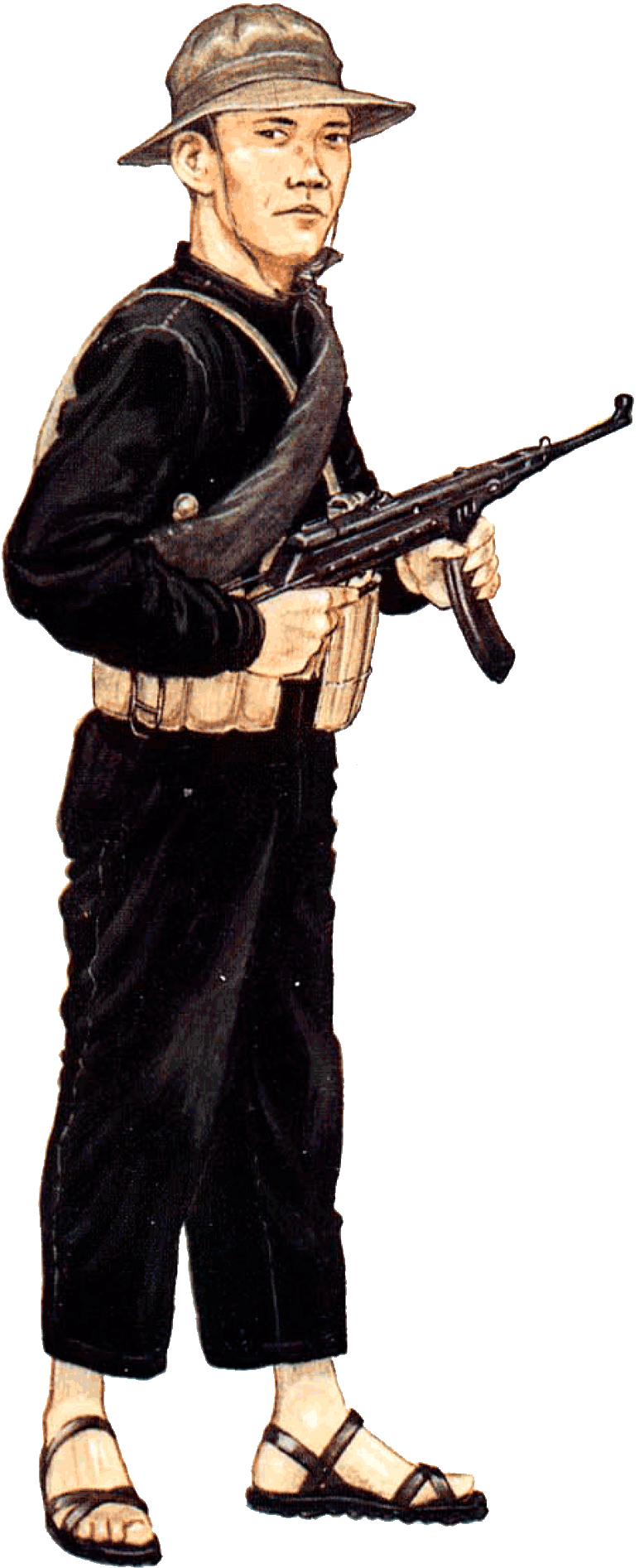
Typical soldier of the Met Cong. Illustration by Mike Chappell.
Communist forces fell into two distinct groups: the North Vietnamese Army (NVA) regulars and the Viet Cong (VC). At the war's beginning, the southern-born Viet Cong operated in true guerrilla style without support from the NVA regulars. As the war intensified, increasing numbers of North Vietnamese made the perilous march south along the Ho Chi Minh Trail to join the fighting. American intelligence estimated that at the time of the offensive, about fifty per cent of the 197 mainforce enemy battalions in the south comprised NVA regulars. At all times, the Hanoi high command dominated their southern brethren. The NVAs objective was to reunify Vietnam: the Viet Cong - fighting under the banner of the National Liberation Front - had the slightly different goal of obtaining a monopoly of political power in the south. American intelligence had identified seven North Vietnamese Army divisions in South Vietnam by the beginning of 1968. They numbered about 50,000 soldiers. Additional NVA regulars served in mainforce VC units.
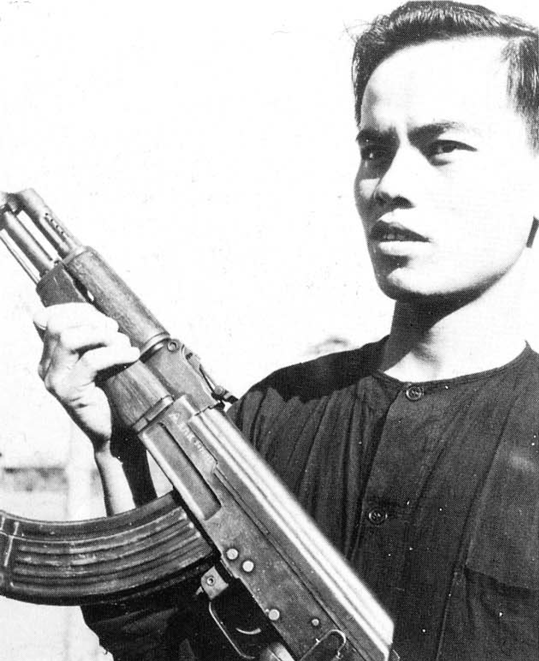
The AK-47 was the standard hand-held firearm on the Communist side. The Russian-designed gas- operated automatic rifle fired a 7.62mm round. It had an effective range of 400 metres and delivered 30 rounds per magazine. Ruggedly built, it was believed by many American soldiers to be greatly superior to their own M-16. In contrast to earlier wars where foot soldiers fired rifles, the AK-47 turned even enemy infantryman into a light machine-gunner. A young Met Cong soldier carries the Chinese version of the AK-47.
Until the war's end, a North Vietnamese soldier sent south returned home only in one of two circumstances. If he belonged to the small cadre held out of battle to reconstruct a battered unit (a practice similar to that used by assault troops in the First World War) he would return to escort replacements back south. A disabling wound was the only other ticket home. As the war dragged on, more and more recruits saw orders sending them south as a death sentence. Yet they went, and, in sharp contrast to American policy, the NVA soldier served for the duration. As one envious American general expressed it: 'Charlie had no DEROS.'
Compared with the Allies, the NVA lived an extremely primitive life. Their health suffered accordingly. A typical NVA prisoner reported that while everyone took malaria pills, due to their poor physical condition, 70 men in his company had contracted the disease by the time of his capture.
It was also a life lacking comfort and pleasure. While during the march south through Laos and Cambodia they occasionally met women at communications and liaison stations, once they neared the combat zone they seldom made contact with the opposite sex. Each evening a political officer harangued the men. He told of combat heroes and of great past and future successes against the APVN and Americans. Typically, a commissar might acknowledge the strength of American aircraft and guns while stressing the moral superiority of the NVA/VC. Although political indoctrination was an important component of orthodox Communist training, at least one veteran reported that it often failed to stimulate the troops for a most basic reason: the political officer did not accompany the men on combat missions and thus was discredited. Periodically travelling entertainment troops arrived to enliven the soldiers' lonely routine. While their arrival was welcome, particularly if the troop featured women, their departure only highlighted the men's isolation. The life of an NVA soldier was one of tremendous physical and emotional deprivation.
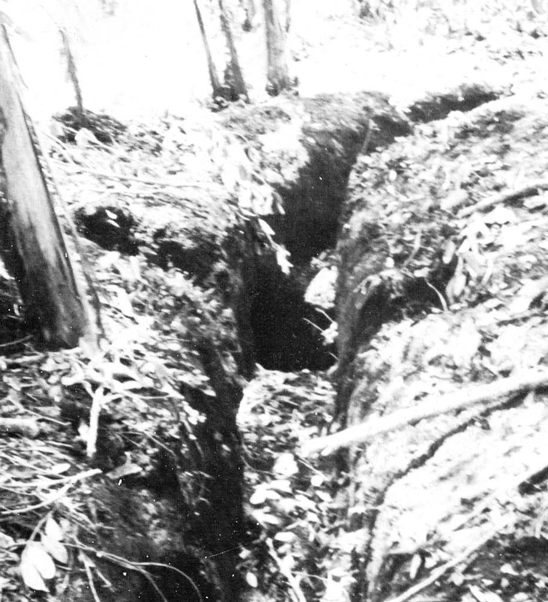
Up until the Tet Offensive, the Viet Cong and North Vietnamese avoided battle except on ground of their own choosing. Usually they tried to draw the Americans into a prepared killing ground that featured well-camouflaged, deeply-dug trenches, bunkers and spider holes. Experienced American officers learned to avoid assaulting unknown numbers of enemy soldiers in prepared positions. Instead, they preferred to fall back and call in air strikes and artillery. However, the imperative to report a sizeable 'body count' drove some aggressive leaders to costly and foolish attacks. The 173rd Airborne's assault on hill 875 in 1967 and the Hamburger Hill action in 1969 were two dismal examples. A trench/tunnel complex uncovered by the 173rd Airborne Brigade.
Within the Viet Cong were two levels of combatants: mainforce (called regular by the Americans) units that numbered about 60,000 men organized into regular combat units, and the paramilitary or guerrilla forces. The latter, in turn, comprised regional, or territorial, guerrillas and local guerrillas. Main force units engaged in full scale combat and were veteran, skilled fighters. The paramilitary units provided logistical support, scouts and guides, and engaged in hit and run ambushes and mine laying. While it is exceedingly difficult to reconstruct the Communist order of battle - it was a source of great debate at the time within Westmoreland's headquarters - on the eve of Tet, some 400,000 paramilitary fighters were present.
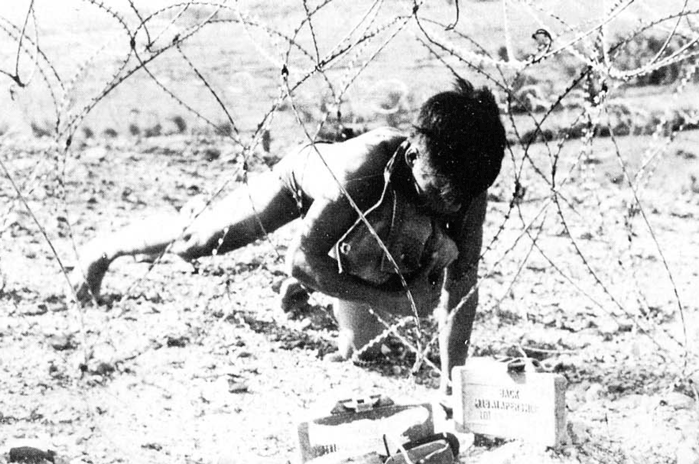
A captured VC sapper reported: 'You had lots of wire around Polei Kleng but it was easy to get through. I just don't think you have a defensive barrier that is effective against us.' At Hue, a spearheading sapper company formed four 10-man teams equipped with two B40 and one 1341 rocket launchers as well as AK and CKZ rifles with 200 rounds of ammunition. Each sapper also carried 20 explosive charges to breach fortified defences. Nearly naked, to avoid tangling in wire, a former VC sapper demonstrates infiltration technique.
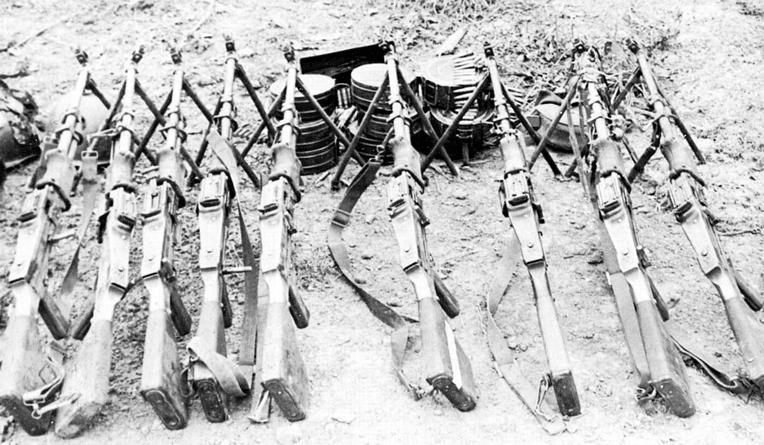
The Soviet RPD machine-gun tired the same ammunition as the American M-60. However, at 10.5 pounds it was less than half as heavy as its counterpart. It was cap able of firing 900 metres, 200 metres less than the M-60, but this seldom mattered in situations where combat ranges typically were less than 20 metres.
The fundamental problems confronting the Communists are well-expressed by the commander of the 2nd Viet Cong Division: 'When the Americans entered the war, we spent all our time trying to figure out how to fight you. The incredible density of your firepower and your mobility were our biggest concerns.'
We have much more interesting information on this site.
Click MENU to check it out!
∎ cartalana.com© 2009-2025 ∎ mailto: cartalana@cartalana.com